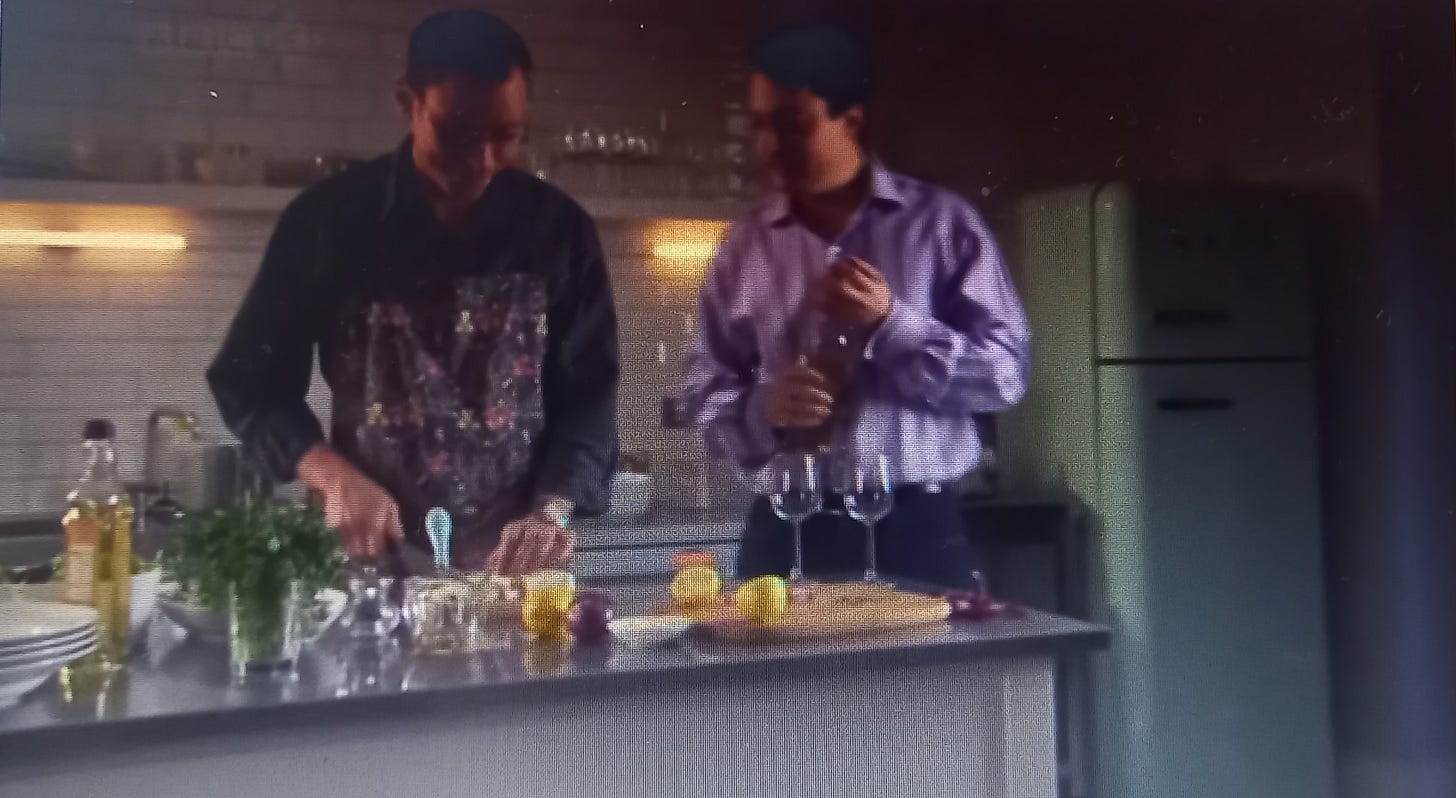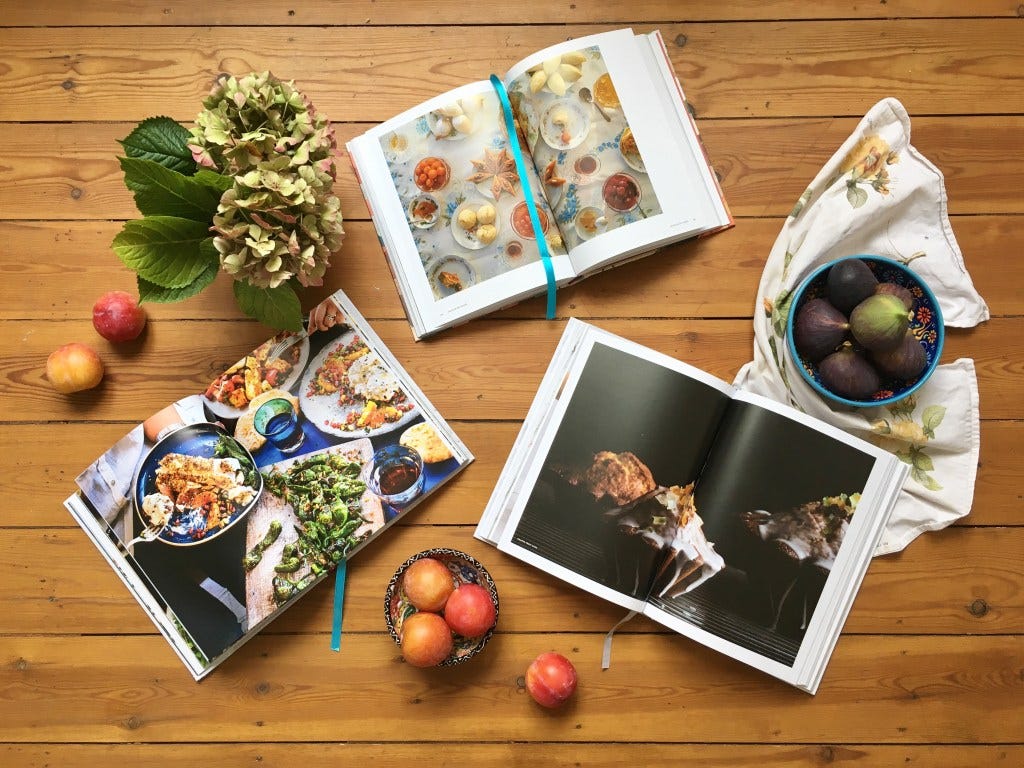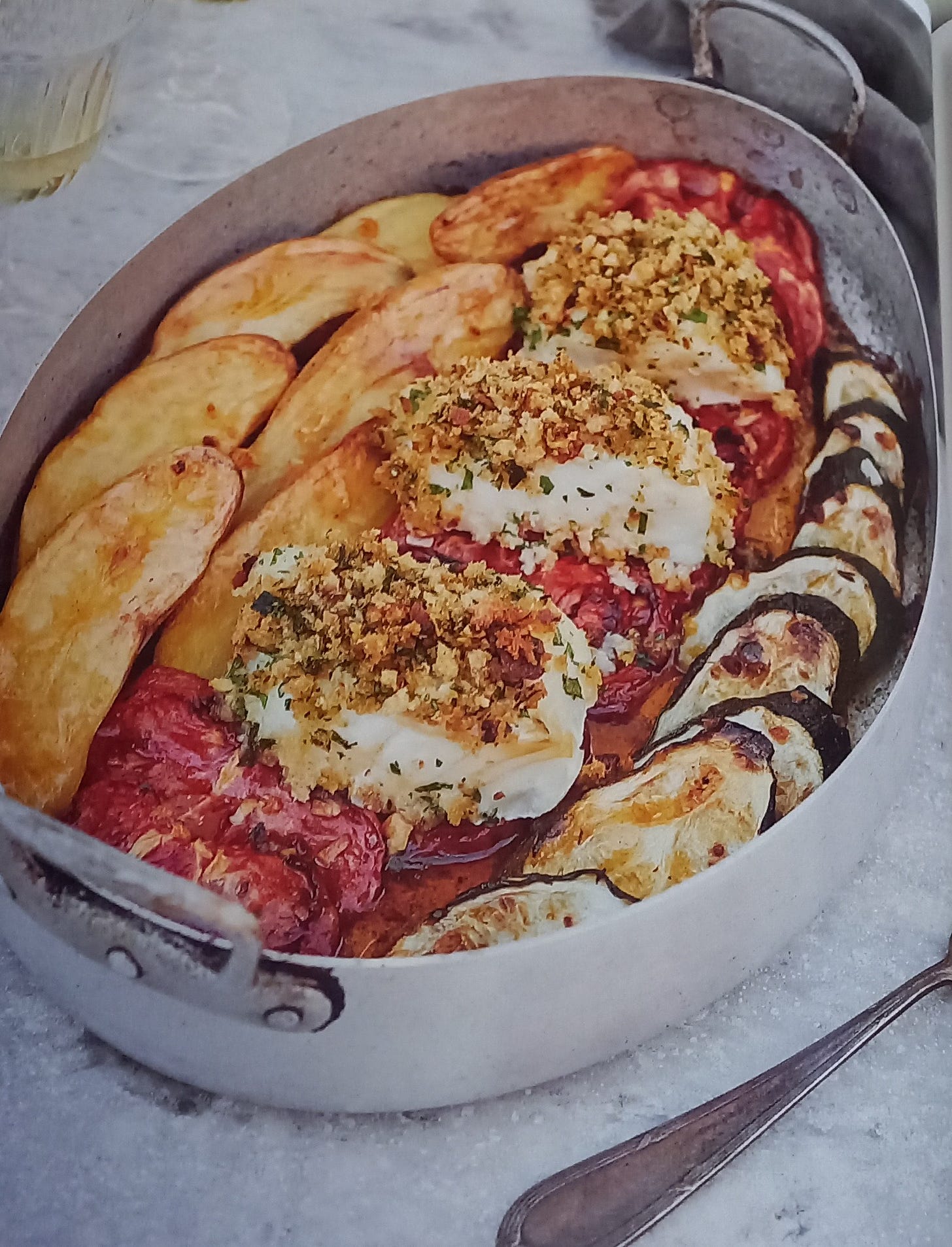As the song says, Come into the garden, Maud
A recipe for herb-roasted fish on a bed of summer vegetables
There’s a much-watched YouTube sketch of British comedians David Mitchell and Robert Webb at a vegetarian dinner party. Mitchell comes into the kitchen to ask Webb what he’s cooking for supper and is dismayed by the answer - some lentil-and-feta concoction. Why, having respected Robert’s food requirements by cooking vegetarian when Robert came to dinner wouldn’t Robert, he asks, have the courtesy to cook meat when carnivore David was invited round. They cook the family cat.
The clip has hundreds of Comments in support of Mitchell’s argument. The TV programme from which it was lifted was made in 2010. In the intervening years, the likes of food writers Yotam Ottolenghi, Olia Hercules, Sabrina Ghayour and adventurous restaurateurs have opened up a whole vegetarian world beyond spinach lasagne*, shining a light on Middle Eastern, Caucasian cuisine and more. They have moved vegetarian food so many mouth-watering miles away from the “Nut-roast-or-mushroom-risotto?” choice grudgingly offered to vegetarians that today’s meat eaters have been more than content to eat alongside them without complaint. Introduced to multi-layered ethnic dishes that are meat-free almost incidentally, carnivores have become as excited as vegetarians.
Which makes the continuing drive to create meat alternatives all the more puzzling. Consumers complain of its unsatisfactory texture, disappointing flavour. Supermarkets are reducing the amount of shelf-space devoted to the market. Plant-based meat-substitute manufacturers are reportedly making heavy loses. Some have gone into liquidation. Vegetarian dishes in restaurants and ethnic cookery books are so interesting and satisfying it’s a wonder why Big Food Biz persists in its drive to provide eaters with meat alternatives.
And yet persist they do. The UK has just received an application from an Israeli company, Aleph Farms, which last week submitted the same to the Swiss Federal Food Safety and Veterinary Office, for regulatory approval to sell its cultivated meats in Switzerland. (Fondue bourguignonne-ish, anyone?)
Cultivated meat is meat cultivated from the cells of a cud-chewing animal or pig. Aleph Farms’ application is a result of the company’s collaboration with Migros, Switzerland’s largest supermarket and meat manufacturer. A joint survey established that 74 percent of Swiss consumers are open to trying cultivated meat, mostly out of a desire to practise sustainability and animal welfare but also out of curiosity - which could result in a one-time only purchase.
The subsequent product causes up to 92 percent less gas emissions and up to 94 percent less air pollution. Made without antibiotics, it uses up to 66 percent less water and up to 90 percent less land. What’s not to love, if you’re desperate for harmless meat. Not sure how nutritious it is. In the milk alternatives field, only 12 percent of them provide the total nutrient values comparable to real whole milk.
Rather than focus on processing plants or cells to provide diners with a foodstuff masquerading as a four-legged food source, why not allow meat eaters to eat the real McCoy - so long as it has been raised humanely year-round on pasture and slaughtered humanely, insofar as that is possible, locally and thoughtfully. And alongside, to promote vigorously the benefits - to the body and the planet - of vegetable and pulse-based dishes that can stand proudly beside any classic meat-based dishes in interest and flavour and texture. Global travel has introduced us to so many predominantly vegetable-based cuisines that have astonished us when eating them in their country of origin, there’s no reason not to grow many of those vegetables commercially to eat them domestically, particularly as temperatures rise. Perhaps okra from Wales could be a possibility, for instance?
Popularising vegetable-based cuisines could drive an increase in the farming of vegetables and away from animals. Nations able to rely on a broader range of produce grown locally would reduce emissions resulting from the transnational import and export of fruit and veg.
Consumers have no real idea of just how much food should cost as opposed to how much it does cost. Selling it to us more cheaply to support buyers struggling financially in these straightened times is losing the supermarkets so much less in profits than is lost to the farmers supplying it, many of whom are being driven out of business by supermarkets’ price cuts.
The cost of what we pay for our food isn’t just about how much it bites into our budgets. It’s about the hidden cost to the environment. This is a global issue, but there’s an interesting experiment about to take place in Europe.
‘Penny’ is a German-French discount supermarket chain with 3,550 stores across the continent. On one day in August, 2017, it pulled all foreign produce and products from its shelves. Click to see just how barren that looks. Now, in the 2,150 branches under the ‘Penny’ banner, it is spending this week selling nine of its products in the meat and dairy range at their true cost, to bring home to its customers the real price of food. This cost relates to their effect on soil, water use, climate, and health. To reflect this, Maasdamer, for instance, a popular German cheese, will increase 94 percent in price. Mozzarella is going up by 74 percent, fruit yogurt by 31 percent. Weiner sausages will almost double from €3.19($3.51) to €6.01($6.62). In the case of cheese, the new prices include 76 cents for damage to the soil caused by intensive farming, 63 cents for pesticides used, 10 cents for groundwater pollution, and the hidden cost of methane and CO₂ emissions harmful to the environment.
Penny is passing the excess proceeds from the sales of the particular products to a charity supporting family-run farms in Alpine regions struggling to survive on low returns and on selling produce whose price at the till is making them a loss. I’d be interested to know if there are any proceeds. Who is going to buy these suddenly expensive goods? Consumers are struggling too, and unlikely to buy products that have increased up to 94 percent in price.
Penny’s COO says the company wanted to created an awareness around the hidden environmental costs of groceries. “We need to put out the uncomfortable message that the prices of our foodstuffs which are accrued along the supply chain in no way reflect the environmental on-costs.” says Stefan Görges. He might like to watch that 2017 video again to remind himself just how much of the chain’s stock comes not from local farmers but from overseas.
Global fintech company IG has done an analysis grading which nations imported and exported the most food during the first year of Covid, 2020. The US came top, with the highest trade value of food commodities imported and exported, at $294.3 billion. The UK, at No.8 behind Brazil and Italy, recorded $87 billion worth of food imports and exports. More significant is that the value of its exports was far lower than its imports, at $26.7 billion. That figure represents a significant food trade deficit - a negative trade balance of $60.3 billion. (Fun fact in all this weight of info: The UN’s Food & Agriculture Organization reports that the most imported food was bananas, 25.5 million of them.)
The UK’s dismal record contributes towards the fact that in the first half of this year, more than double the food and drink businesses in the nation went into administration - 56 of them in six months compared to 53 for the whole of 2022. The hangover of Covid plus higher inflation and energy costs plus the effect of ‘PuddingBin’ (PDDNBIN = the Political Disaster that Dare Not Breathe Its Name; I just made that acronym up - otherwise whispered as Brexit) with its resultant increase in the volume of import and export regulations and paperwork, and reduction in temporary farm labourers from overseas, are all responsible. (Woe betide if you have any food allergy - now on the increase as a result of pollution, less exposure to microbes, and dietary changes: Prices of allergy-free alternative foods, many from overseas, have more than doubled, to as much as 138 percent of their counterparts.)
Supermarkets put feeding the voracious appetites of their shareholders above taking care of their suppliers’ welfare, as does Big Food Biz. It’s more likely those shareholders sit over their suppers fantasising about how idyllic it might be to use their dividends to buy some lovely farm than grouse about the cost of the food they eat. (What they do with grouse is shoot them.) Would they even notice if that cost were to reflect the real price of their dinner? Only if it were to affect their annual dividends pay-out. Perhaps money might be raised among concerned citizens to buy the 5 percent of shares to allow one of them a place at Annual General Meetings to contest such pay-outs.
Forgive the rant. And I haven’t even mentioned the environmental threat to fish! But I’m against deprivation. Denying ourselves good food, including meat and fish, shouldn’t be necessary if only we buy with care. A creature raised by industrial food complexes lives in utter cruelty. Its sale benefits the bottom lines of the shareholders, not the health of its consumers, pumped as it is with antibiotics and hormones. If we choose line-caught fish and pasture-raised meats, we are at least supporting the small and considerate producers whose livelihoods depend on its continuing provision.
This is a summer vegetable recipe which ekes out a serving of fish. And can be made without any at all and with the addition of other vegetables like shallots, courgettes/zucchine (not zucchini, a zucchina is a feminine noun), carrots, leeks, and more and served, perhaps, with a salsa verde.
Serves 4
500g/1 lb assorted vegetables
4 tablespoons olive oil + more for drizzling
leaves from 4 sprigs fresh thyme
breadcrumbs from 4 thick slices of stale bread (or Panko as needed)
1 tablespoon light or vegetable oil
4 fillets of line-caught halibut, salmon, hake, or cod, 2½ cm/1 inch thick
Preheat the oven to 180C/350F.
Peel any root vegetables, halve the tomatoes, thickly slice any others. Toss them in a large bowl with 4 tablespoons of olive oil, half the thyme leaves, season to taste and layer them in a roasting pan or dish. Roast for 30 minutes or until soft and beginning to char at the edges.
In a pan over medium heat, toss the breadcrumbs in the other oil, toss the breadcrumbs in it until gold then scrape into a bowl. Finely chop the remaining thyme and the parsley, and mix them in.
Tilt the roasting pan and spoon the juices over the vegetables. Lay the halibut on top, drizzle over a little olive oil, season then cover with the breadcrumbs. Return the pan to the oven and bake a further 4-6 minutes till the fish is opaque. It will continue to cook once the pan is removed.
*Lasagna refers to one sheet only of the pasta, not the whole dish. Lasagne is the plural, not lasagnas, the American formula.








Wow Julia you really captured my mood today and much like yourself I abhor waste. Why not focus on the ingredients we have already in our local areas instead of relying on fake meat despite its attractiveness. Those facts mentioned are very remarkable!
Thank you for the important rant Julia. This is such an important topic. Imagine if ALL companies were forced to charge the true cost of their goods. Perhaps armaments manufacturers would go out of business since they would be forced to take into account the consequential costs to society of deaths caused by their products. (Well we can dream!) May I recommend an excellent book on this topic, "Six Capitals" by Jane Gleeson-White (Allen and Unwin pub).